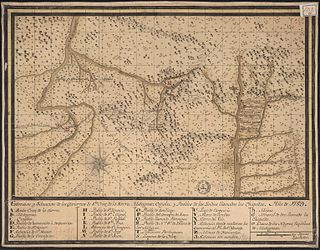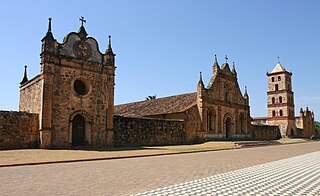History
A variety of indigenous ethnic groups inhabited the Chiquitanía prior to Spanish arrival, which was marked by the 1559 founding of Santa Cruz de la Sierra at a point far to the east of the city's present location. Missionary contact was unsuccessful during the first nine decades of the 1600s. [9]
The Chiquitos were in fact well formed and powerful, of middle height and of an olive complexion. They are an agricultural people, but made a gallant resistance to the Spaniards for nearly two centuries. In 1691, however, they made the Jesuit missionaries welcome, and rapidly became civilized. The Chiquito language was adopted as the means of communication among the converts, who soon numbered 50,000, representing nearly fifty tribes. [6]
The formative experience of the Chiquitano ethnicity was their common evangelization and confinement to towns under the authority of Jesuit missionaries from their 1692 arrival at San Javier de los Piñocas (in what is now Ñuflo de Chávez Province) until their 1767 expulsion from Spanish colonial possessions. Missions governed settlements known as reductions at San Javier de los Piñocas, Concepción, San Ignacio, Santa Ana, San Rafael, San José, San Juan, Santiago, Santo Corazón, and San Miguel. Each mission town incorporated one to three thousand residents. [10] Jesuits emphasized prayer and work as the main activities of a worthy life. They promoted permanent settlements, cattle husbandry, and loom-based weaving as aspects of economic life. [11] The reductions also began a centuries-long pattern of Chiquitano Indian labor benefiting outsiders. During the mission period, Chiquitanos were also recruited as soldiers in Spanish colonial wars. [9] Swedish anthropologist Erland Nordenskiöld described the Jesuit legacy as follows: "The Jesuits protected the Indians from other whites, but divested them of their freedom and made them so dependent that after the expulsion of the missionaries they were easy prey for unscrupulous whites. Actually they set the stage for the extinction of many Indian tribes." [12]
Following the Jesuits' expulsion, some Chiquitanos were incorporated into mestizo-owned ranches and farms, where they served as unfree laborers; others retreated from the villages, living in smaller camps. [11] The rubber boom across South America brought a new industry to the region from 1880 to 1945, staffed once again by Chiquitano laborers. Work was often involuntary, and the conditions extremely harsh, resulting in deaths from workplace accidents, malnutrition, "diseases such as malaria, beriberi, and scurvy; and the overall exploitative practices of the whites." [13] As rubber workers, Chiquitanos experienced debt peonage and forced labor, but were primarily rented out by wealthy mestizos on whom they were dependent. Chiquitanos also built parts of the Santa Cruz–Corumbá Railway under this arrangement. [9]

Chiquitania is a region of tropical savannas in the Santa Cruz Department in eastern Bolivia.

The Jesuit reductions were a type of settlement for indigenous people specifically in the Rio Grande do Sul area of Brazil, Paraguay and neighbouring Argentina in South America, established by the Jesuit Order early in the 17th century and wound up in the 18th century with the banning of the Jesuit order in several European countries. Subsequently it has been called an experiment in "socialist theocracy" or a rare example of "benign colonialism".
The Confederation of Indigenous Peoples of Bolivia,, is a national representative organization of the Bolivian indigenous movement. It was founded in October 1982 in Santa Cruz de la Sierra as the Confederation of Indigenous Peoples of the Bolivian East, with the participation of representatives of four indigenous peoples of the Bolivian East: Guarani-Izoceños, Chiquitanos, Ayoreos and Guarayos.

José Miguel de Velasco or Velasco is a province in the Santa Cruz department of Bolivia. Its capital is San Ignacio de Velasco. The province is named after the Bolivian president José Miguel de Velasco Franco. It was created by law on October 12, 1880, during the presidency of Narciso Campero. Until its creation it was integrated into Chiquitos Province.
Chiquitano is an indigenous language isolate spoken in the central region of Santa Cruz Department of eastern Bolivia and the state of Mato Grosso in Brazil.

San Ignacio de Velasco, is the capital of the José Miguel de Velasco Province and the San Ignacio de Velasco Municipality in the Santa Cruz Department of Bolivia.

Concepción is a town in the lowlands of eastern Bolivia. It is known as part of the Jesuit Missions of Chiquitos, declared in 1990 a World Heritage Site, as a former Jesuit Reduction.

The Jesuit Missions of Chiquitos are located in Santa Cruz department in eastern Bolivia. Six of these former missions collectively were designated as a UNESCO World Heritage Site in 1990. Distinguished by a unique fusion of European and Amerindian cultural influences, the missions were founded as reductions or reducciones de indios by Jesuits in the 17th and 18th centuries to convert local tribes to Christianity.

San Rafael de Velasco or San Rafael is the seat of the San Rafael Municipality in the José Miguel de Velasco Province, Santa Cruz Department, Bolivia. It is part of the Jesuit Missions of Chiquitos. In 1990 it was declared a World Heritage Site.

San José de Chiquitos or simply San José is the capital of Chiquitos Province in the Santa Cruz Department, Bolivia. It is known as part of the Jesuit Missions of the Chiquitos, which is declared in 1990 a World Heritage Site, as a former Jesuit Reduction.

San Javier is the seat of San Javier Municipality in Ñuflo de Chávez Province, Santa Cruz Department, Bolivia. The mission of San Javier is known as part of the Jesuit Missions of the Chiquitos, declared in 1990 a World Heritage Site, as a former Jesuit Reduction.

San Miguel de Velasco or simply San Miguel is a town in the Santa Cruz Department, Bolivia. It is the capital of San Miguel Municipality, the second municipal section of José Miguel de Velasco Province. It is known as part of the Jesuit Missions of the Chiquitos, which was declared a World Heritage Site in 1990, as a former Jesuit Reduction. The wood and adobe church has an elaborate interior.

Santa Ana de Velasco is a small town in the Santa Cruz Department, Bolivia.
Gorgotoqui is a currently undocumented extinct language of the Chiquitania region of the eastern Bolivian lowlands.

Martin Schmid, also known as Esmid was a Swiss Jesuit, missionary, musician and architect, who worked mainly in the Chiquitos Province of what is now Bolivia.
Camba is a word historically used in Bolivia to refer to the indigenous population in the eastern tropical region of the country, or to those born in the area of Santa Cruz, Beni, and Pando. Nowadays, the term "Camba" is used predominantly to refer to eastern Bolivian populations of mixed Spanish, Chane, and other indigenous Amazonian descent born in the eastern lowlands in and around Santa Cruz de la Sierra.

Santiago de Chiquitos is a small town in Roboré Municipality in Chiquitos Province, Santa Cruz Department, Bolivia. The mission of Santiago de Chiquitos is one of the Jesuit Missions of the Chiquitos.

San Juan de Taperas is a village in San José de Chiquitos Municipality in Chiquitos Province, Santa Cruz Department, Bolivia. The ruins of the mission of San Juan Bautista, one of the Jesuit Missions of the Chiquitos, lie near the village. Since only the ruins of a stone tower survive near the present village of San Juan de Taperas, San Juan Bautista is not one of the six Jesuit Missions of Chiquitos recognized as UNESCO World Heritage Sites.

Santo Corazón is a village in San Matías Municipality in Ángel Sandoval Province, Santa Cruz Department, eastern Bolivia. The mission of Santo Corazón is one of the Jesuit Missions of the Chiquitos.

San Ignacio de Zamucos or San Ignacio was a Jesuit mission in Santa Cruz Department, Bolivia that was founded in 1724 and abandoned in 1745. The inhabitants of the mission were the Zamucoan-speaking Ayoreo.













